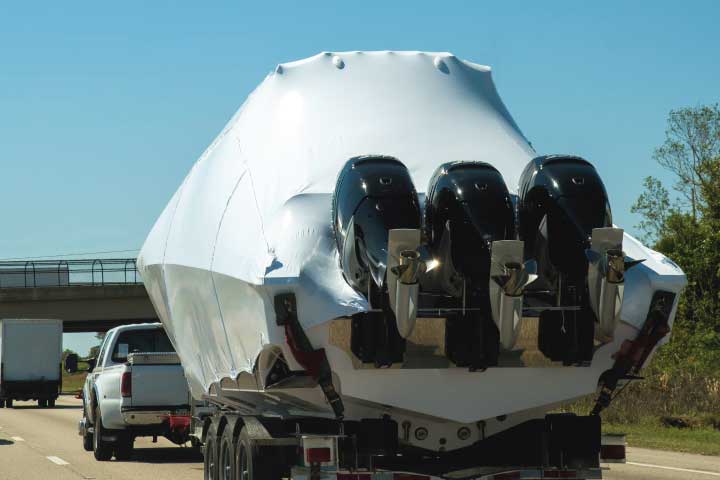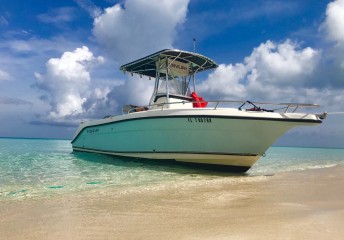How Does Long-Distance Trailering Work?
Last Updated on December 21, 2022 by Boatsetter Team
It’s one thing to tow your boat a few miles to the ramp; it’s another to tow it a long distance. It requires much more preparation, but taking your boat on a cross-country vacation, embarking on a snowbird exodus to a warmer climate, or seeking a little angling adventure in Alaska is well worth the hassle. So, how do we do it? Here’s how long-distance trailering works:
Put your boat to work— Start earning an avg. of $20K yearly with Boatsetter
First, prepare your vehicle

Towing can put a lot of stress on a tow vehicle, especially if your route covers mountain passes or even hilly terrain. Engine oil and transmission temperatures will climb, which will cause the cooling system to work harder. It’ll be a good investment to have a pro technician give your rig a once-over before you cast off for adventure.
Start with fresh oil and filter, so you know you’ve got lube with a full complement of additives in the engine– the heat of towing breaks down those additives in a hurry. For this reason, quality, synthetic oil is always a good bet in the long tow.
READ MORE: How to Load a Boat on a Trailer (Retrieving Your Boat)
Check out the cooling system. Ask the tech to inspect the radiator and heater hoses if you have an older vehicle. Make sure the brakes are in good shape. Your tires should have good tread and be properly inflated. And don’t forget to check the pressure in your spare.
Ask the tech to give the trailer hitch a once-over while the vehicle is up on the lift. Now is also the time to make sure you’re towing with the ideal ball mount, which will have the trailer level, or horizontal, when it’s hitched to the vehicle rather than angled up or angled down.
Now, prepare the trailer
Three trailer issues that could cause you trouble on the road are flat tires, failed wheel bearings, and trailer light issues. We go over each in depth below:
Tires

A failed tire caused by low air pressure is probably the number-one cause of trailer trouble, so it’s good practice to check trailer tire air pressure before hitting the highway. Inflate to the maximum rating on the tire or as listed on the capacity sticker on the trailer. Heat builds up in a tire with low pressure and can cause the tire to delaminate and fail, a dangerous situation at 70 mph!
Pro Tip: Don’t forget to check the pressure in the spare tire.
Tires more than six years old should be replaced, according to the National Transportation Safety Board.
Pro Tip: The last four digits of the DOT code on the tire sidewall indicate the month, and year the tire was made; “3517” would indicate the tire was made in the 35th week of 2017.
The tires under your trailer should all be ST (Special Trailer) type tires, which are designed specifically for trailer use, with stronger cords and stiffer sidewalls than LT (Light Truck) tires.
Consider bringing an extra mounted spare, especially if you have a tandem-axle trailer.
READ MORE: How to Back Up a Boat Trailer in 7 Easy Steps
Bearings
Make sure your wheel bearing protectors are filled with grease. Even with bearing protectors, it’s a good idea to inspect and repack the wheel bearings with fresh grease every three to five seasons, another task for your friendly tech if you don’t want to handle this yourself.
Consider packing a wheel bearing replacement kit– available from auto parts or RV stores– and the tools required to replace a bearing. It’s not that hard of a job, even in a parking lot, and it will get you back on the road.
Lights
Of course, check all your trailer lights, and pick up some spare bulbs to throw in your glove box. A spare trailer wiring plug and a length of trailer wire will be handy to have along to repair your harness if it becomes damaged.

Ready for a MacGyver moment?
You can’t go wrong with putting together a tool kit for your unexpected MacGyver moment. We’ve already mentioned a jack and tire-changing, and wheel bearing repair. Also handy might be a wire stripping tool and some crimp-type wire connectors for fixing trailer wiring, and some basic hand tools.
Extra driving tips can’t hurt
- Tip 1 – Most vehicles we use for towing a boat have a trailering mode– check your owner’s manual if you are not sure. On some vehicles, trailing mode keeps the transmission from shifting into overdrive. (Pro Tip: Trucks may have a tow mode that changes the shifting pattern to help them handle the heavy load.)
- Tip 2 – Give yourself time to brake effectively! Even with trailer brakes, your stopping distance will be much longer with the weight of that big boat on the hitch. Slowing down will also help you stop more quickly in an urgent situation.
- Tip 3 – Lighten your load by cleaning any unnecessary gear out of your boat. And if possible, run the fuel level down in the boat fuel tank. If your boat holds 80 gallons of gas, a full tank will weigh 480 pounds– yikes! Keep in mind an easier tow means an easier brake.
- Tip 4 – Fuel your boat up when you safely reach your destination.
About Boatsetter
Boatsetter is a unique boat-sharing platform that gives everyone — whether you own a boat or you’re just renting — the chance to experience life on the water. You can list a boat, book a boat, or make money as a captain.
List. Rent. Earn— Only at Boatsetter

Charles Plueddeman is a self-employed writer and photographer based in Wisconsin. A staff editor and contributor to Boating Magazine since 1986, he is the author of its “Off My Dock” column. In the marine realm he specializes in engine technology and trailerable boats. His editorial work has appeared in many national publications, including Popular Mechanics, Men’s Journal, Playboy, Popular Science, Cycle World, and Harley-Davidson Enthuisast.










